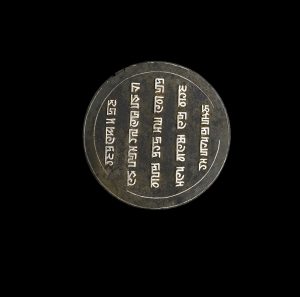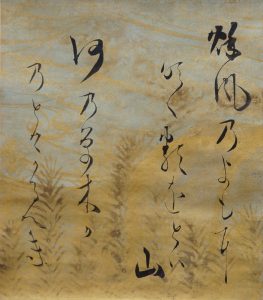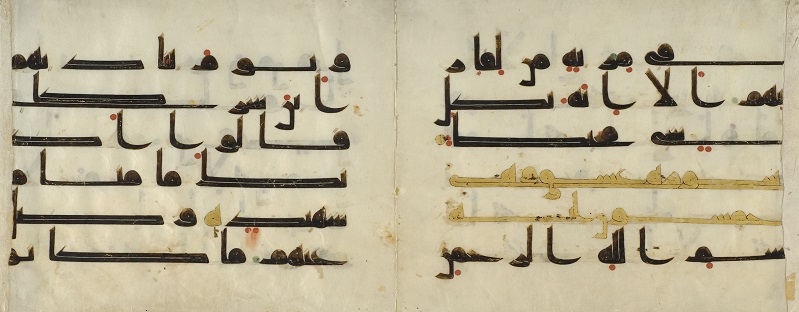Wide Array of Works Includes Poetry, Bible, Passport
Kansas City, MO. Oct 18, 2017–More than Words: The Art of Calligraphy across Asia unveils the most prestigious art form of Asia, where calligraphy is held in greater esteem than painting or sculpture. The exhibition opens at The Nelson-Atkins Museum of Art in Kansas City Oct. 21, 2017 and runs through July 8, 2018. Ranging in date from circa 1200 B.C.E. to the present, spanning Iraq to Japan, the exhibition includes a 9th-10th-century Qu’ran folio in the elegant Kufic script in ink and gold, a 17th-century Armenian manuscript of the Four Gospels by Mesrop of Xizan, and a rare Mongrol passport inlaid in silver in ‘Phags-pa script, a language now dead. Works by Shahzia Sikander, Ambreen Butt, Haji Noor Deen, and Shao Yan demonstrate contemporary artists’ use of calligraphy as a mode of expression today.

“This exhibition celebrates the beauty and power of writing, bringing together remarkable works of art from across time and the vast Asian continent,” said Julián Zugazagoitia, Menefee D. and Mary Louise Blackwell CEO & Director of the Nelson-Atkins. “The art is arranged thematically, allowing visitors to draw connections across many styles and cultures”.
With more than 50 pieces drawn from the Nelson-Atkins holdings as well as loans from distinguished private collections, the exhibition includes a number of recognized masterpieces, including a 6th-century Chinese Buddhist sutra; a composition by Mir ‘Ali al Sultani from the Muraqqa Gulshan for Emperor Jahangir; and superb examples by Ming Dynasty calligraphers such as Wang Duo (1592–1652) and Huang Daozhou (1585–1646), and Japanese Obaku monk calligraphers.
“Beautiful scripts were first developed in Islamic cultures of West Asia to communicate sacred texts, but became revered as art forms in their own right,” said Kimberly Masteller, Jeanne McCray Beals Curator of South and Southeast Asian Art. “In East Asia, ancient ritual scripts evolved into elegant styles used for official communication, aesthetic contemplation, and personal expression.”
An introductory section displays superb examples of materials and techniques, including an exquisite Ottoman calligraphy exercise book and a leaf from Wen Peng’s magisterial Thousand Character Classic. The following sections illustrate the varied roles of calligraphy. Transmitting Faith and Knowledge shows how writing not only preserved and spread the sacred texts of Asia’s great religions—Buddhism, Islam, Hinduism, Jainism, and Christianity–it also exalted them. The exhibition shows that these religions inspired exquisite calligraphic works in many different scripts across Asia. The act of writing down new ideas for scientific and philosophic treatises to preserve them for future scholars also resulted in calligraphic works of great beauty.

In Word, Poetry, and Image, visitors will encounter the relationship between poetry and visual imagery in Asia. In addition to the illuminated frontispiece from a manuscript of Sa‘di’s Bustan, this section includes a landscape handscroll by the Chinese artist Gao Fenghan (1683–1749), which blends image and calligraphy into a seamless experience of word and visual representation. Japanese artist Hon’ami Kōetsu (1558 – 1637) applied delicate calligraphy that seems to float over the decorative design, painted by Tawaraya Sōtatsu (early 17th century) in a collaborative work. Such layered painting and calligraphic exampless are unique to Japan and are among the most delicate combinations of image and word ever created.
The diverse roles (and styles) of writing in the section Communicating Authority is exemplified by such varied examples as Shang Dynasty (16th century –1046) oracle bones, cuneiform tablets from
Mesopotamia, pages from a Mongol Shahnameh (Book of Kings), a rare iron Mongol passport like the one Marco Polo carried, and a powerful calligraphic handscroll by Ming dynasty general Xiong Tingbi (1569-1625 ).
Image captions: Mongol Passport (Paiza). China or Mongolia, Yuan dynasty (1271–1368), late 1200s–1300s. Iron inlaid with silver. Loan: Courtesy of Vahid and Cathy Kooros with the cooperation of the Museum of Fine Arts, Houston
Calligraphy by Hon’ami Kōetsu (1558–1637); Paper design by Tawaraya Sōtatsu (ca. 1570–1640). Poem Card with Designs of Pampas Grass. Japanese, Momoyama to Edo periods (1573–1868), late 1600s to early 1700s桃山後期または江戸初期 本阿弥光悦墨蹟 俵屋宗達作色紙. Poem card (shikishi) mounted as a hanging scroll; ink, color, gold, and silver on paper. Image: 8 × 7 inches (20.32 × 17.78 cm). H. Christopher Luce Collection
Folios from a Qur’an. Iraq, Syria or North Africa. ‘Abbasid period (750–1258), 800s–900s. Ink and gold on vellum. 8 1/2 x 21 inches (21.59 x 53.34 cm). Purchase: William Rockhill Nelson Trust
The Nelson-Atkins Museum of Art
The Nelson-Atkins in Kansas City is recognized nationally and internationally as one of America’s finest art museums. The museum, which strives to be the place where the power of art engages the spirit of community, opens its doors free of charge to people of all backgrounds. The museum is an institution that both challenges and comforts, that both inspires and soothes, and it is a destination for inspiration, reflection and connecting with others.
The Nelson-Atkins serves the community by providing access to its renowned collection of nearly 40,000 art objects and is best known for its Asian art, European and American paintings, photography, modern sculpture, and new American Indian and Egyptian galleries. Housing a major art research library and the Ford Learning Center, the Museum is a key educational resource for the region. In 2017, the Nelson-Atkins celebrates the 10-year anniversary of the Bloch Building, a critically acclaimed addition to the original 1933 Nelson-Atkins Building.
The Nelson-Atkins is located at 45th and Oak Streets, Kansas City, MO. Hours are Wednesday, 10 a.m.–5 p.m.; Thursday/Friday, 10 a.m.–9 p.m.; Saturday, 10 a.m.–5 p.m.; Sunday, 10 a.m.–5 p.m. Admission to the museum is free to everyone. For museum information, phone 816.751.1ART (1278) or visit nelson-atkins.org.
For media interested in receiving further information, please contact:
Kathleen Leighton, Manager, Media Relations and Video Production
The Nelson-Atkins Museum of Art
816.751.1321
kleighton@nelson-atkins.org
